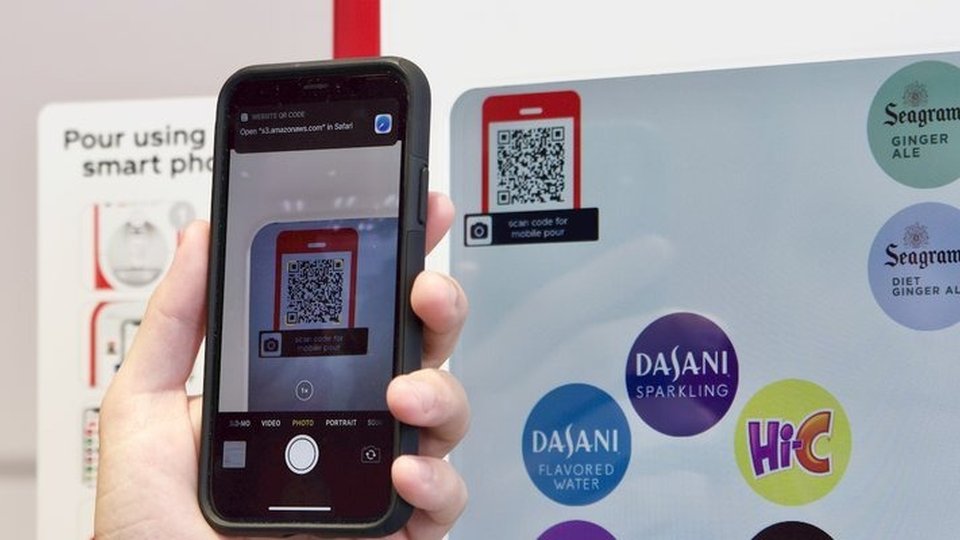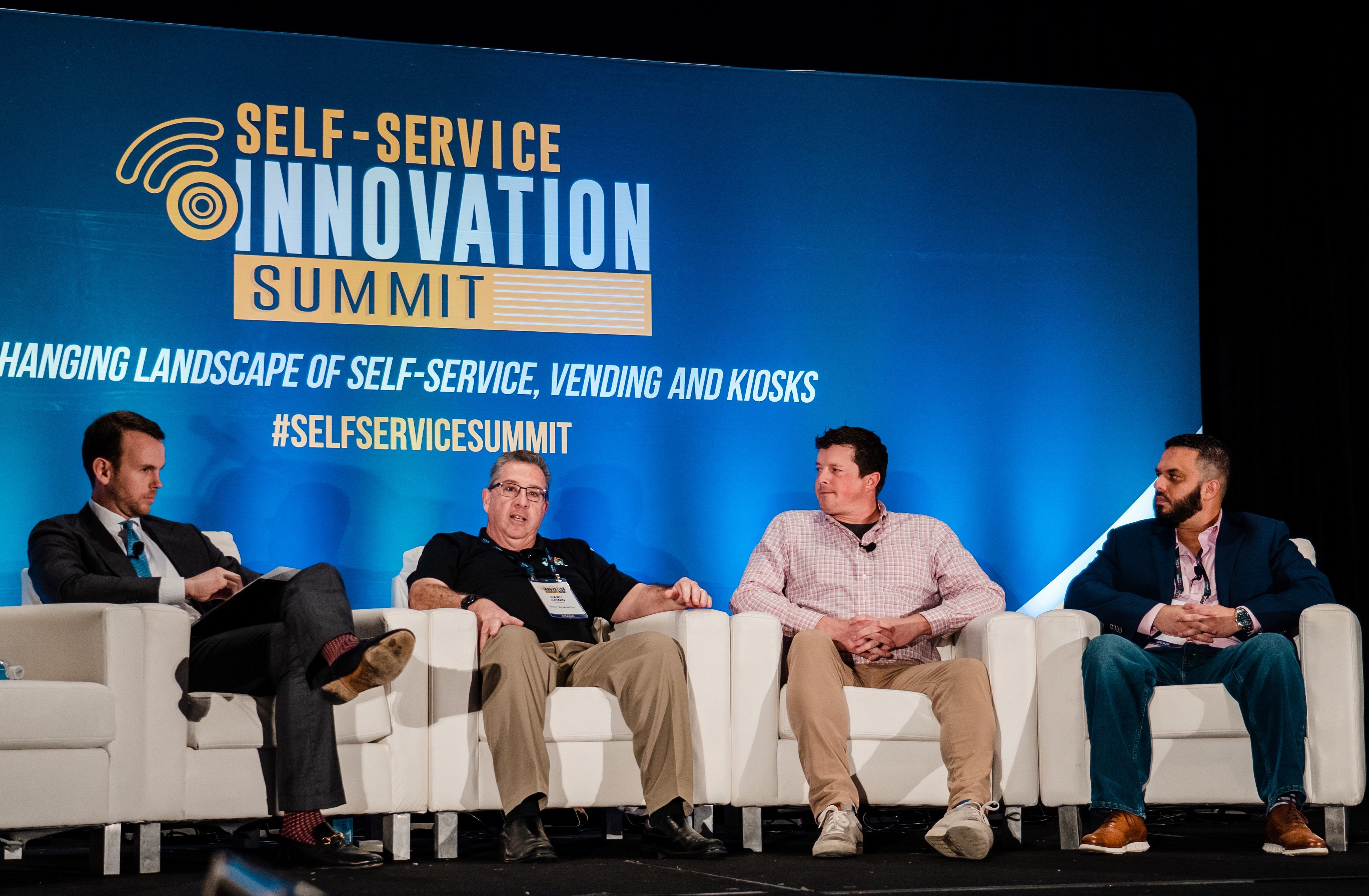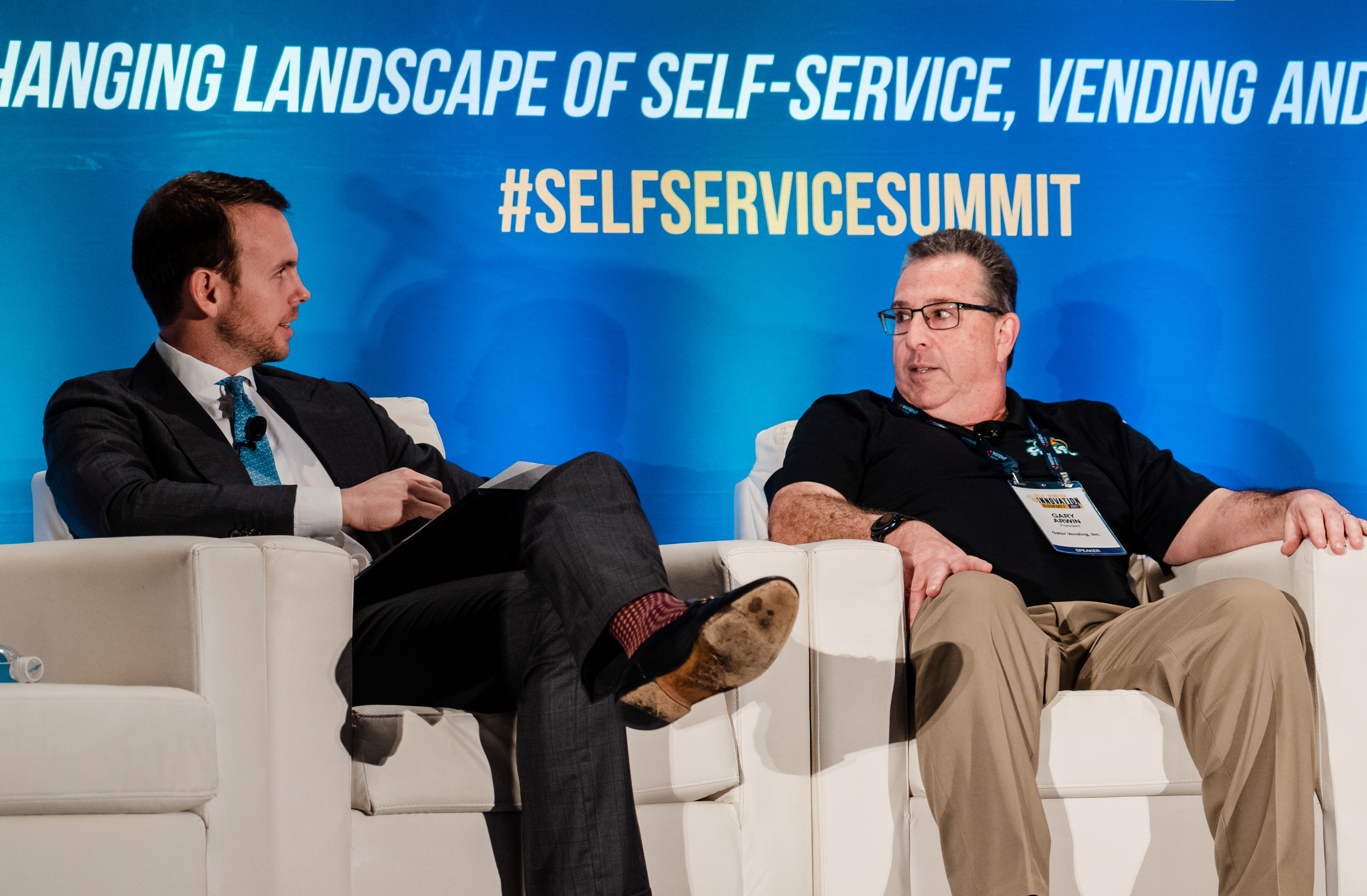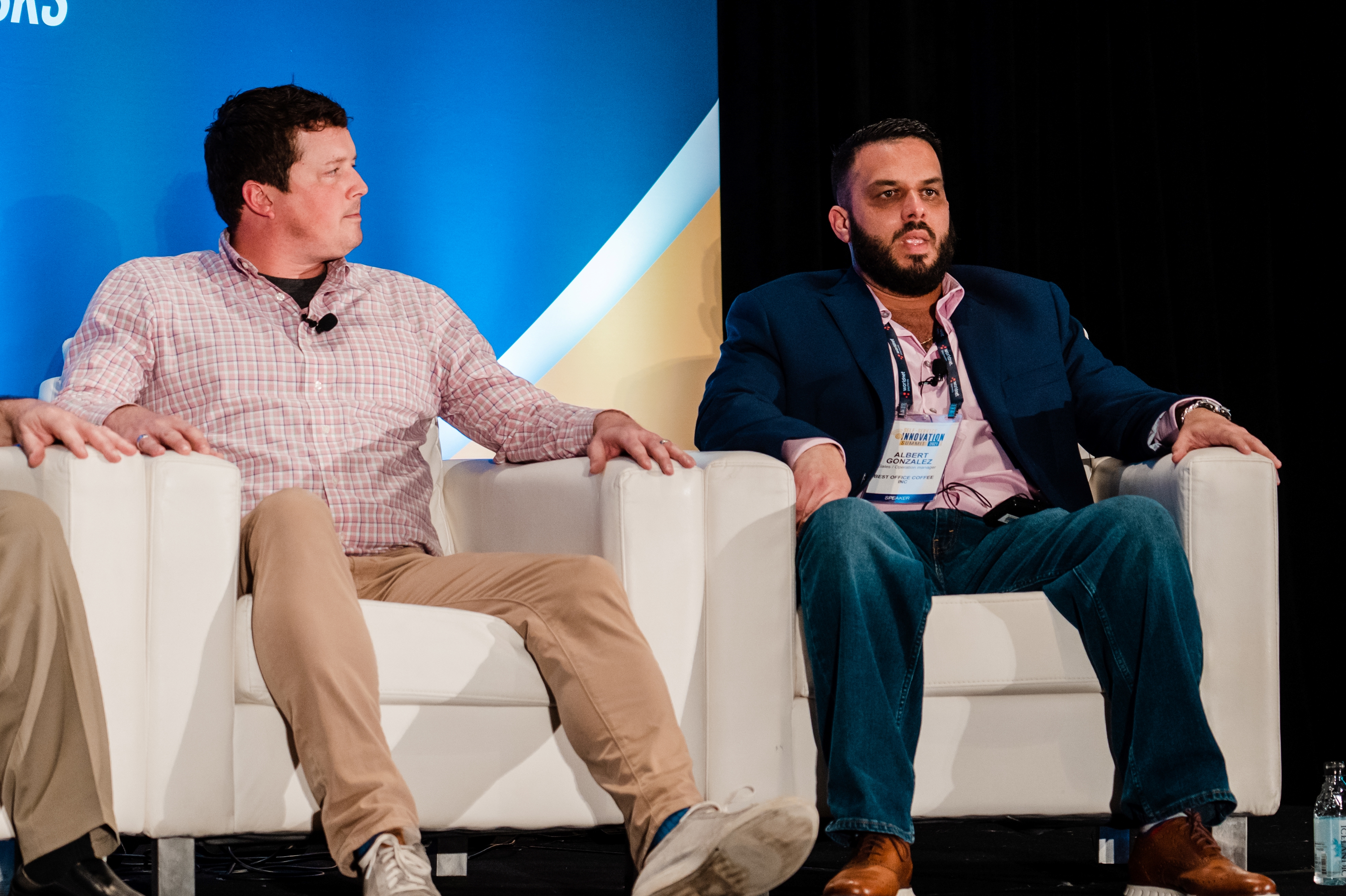Vending
Touchless technology: Benefits beyond safety for convenience services
Convenience services operators have discovered the mobile app solutions that enable touchless interaction give them the added benefit of getting to know customer needs better.

January 26, 2022 by Elliot Maras — Editor, Kiosk Marketplace & Vending Times
When the coronavirus pandemic struck in 2020, consumers became more concerned about safety in the workplace. In response, self-service equipment manufacturers introduced various technologies such as mobile phone based ordering and air touch buttons to allow customers to select and pay for products without having to touch hard surfaces.
 |
| James Siggers of Invenda Group AG, left, introduces panelists Gary Arwin, Gator Vending; Michael Lovett, Capital Provisions and Albert Gonzalez, Best Office Coffee Service. |
Vending, coffee service and micro market operators that embraced these solutions found a receptive customer audience.
However, a panel during the Self-Service Innovation Summit last month confirmed touchless self service solutions offer benefits beyond safety concerns and are expected to remain relevant in the post pandemic era.
James Siggers, head of business development, EMEA, Invenda Group AG, a Switzerland based provider of hardware and software solutions for kiosks, vending machines and digital signage, moderated the panel, titled, "Touchless Vending and Coffee Service Machines: Success Beyond COVID?"
Benefits beyond safety
While safety concerns have somewhat subsided since the start of the pandemic, convenience service operators have discovered the mobile app solutions that enable touchless interaction give them the added benefit of getting to know customer needs better.
"It is in fact a way to engage with consumers and get to know them," panelist Michael Lovett, CEO, Capital Provisions, a Los Angeles provider of vending, micro markets and coffee service, said regarding touchless technology.
Lovett said his company uses the Vagabond Vive mobile payment app that allows the consumer to browse a machine menu on their phone, make a selection and pay with whatever payment system they have stored on their phone.
"If you have a relationship with them through their phone, (it is) similar to the way that Uber has a relationship people enough that they put all the taxi companies out of business," he said. "People become loyal. They start telling you about what they want in their breakroom, and it can be used to great advantage."
"We've got a tremendous opportunity to know what consumers are buying, what their preferences are, to influence them to purchase products that deliver higher margins or higher rebates," he said.
Lovett said his company's goal is to "graduate from being a vending operation into a retailer."
Converting vending to micro markets
The mobile phone app also helps Lovett's company convert vending locations to micro markets, which allows them to offer more product variety and boost sales and profitability.
"It's important to us to do that as much as possible in vending…because that same user interface allows us to convert that (vending) account to a (micro) market," he said. "Instead of just selling them snacks and drinks out of a machine we're now able to sell them snacks, drinks and fresh food and meals."
The app also allows the company to promote special offers to the customer and change prices as products approach expiration dates.
"We throw happy product pricing hours," he said.
"This also gives us a chance to expand the foodservice in the breakroom beyond the machine or beyond what's inventoried in the market," Lovett said. The company allows the customer to order from local food sources, such as local delis.
He said the convenience services industry should double in sales from the present $25 billion in 20 years.
 |
| Moderator James Siggers poses a question to Gary Arwin of Gator Vending. |
Technology improves
Panelist Gary Arwin, president, Gator Vending, an Orlando, Florida based convenience services operation, agreed with Lovett that educating customers on how to use technology will allow the operator to get a bigger share of consumer food purchases. He said new technology in general has increased customer engagement for self service and provided more data to learn what the customer wants.
Arwin, who has 500 vending machines and 20 micro markets as well as coffee service and water cooler service, said he began exploring touchless technology long before the pandemic. He said most touchless technologies failed initially, but the failure rate has "decreased immensely and there's a lot of good product on the market for touchless."
New technology has increased customer engagement for self service and provided more data to learn what the customer wants, Arwin said.
In addition to touchless coffee machines, Arwin said his company has water coolers that customers operate by scanning a QR code on the machine.
"All you (as the user) are doing is placing the cup underneath the spigot and utilizing your phone so there's no touchpoints for the water coolers," he said.
For vending, Arwin's company uses the PayRange app that allows a customer to pay via their phone, although the customer still has to touch the machine to make their selection.
For micro markets, Arwin offers a totally touchless experience using Parlevel Systems software that allows the customer to make a selection using an app and then scanning the product with the phone.
Customers were impressed with the touchless offerings, Arwin said.
"It's kind of a cool feature to just use your phone and make a purchase," he said.
Safety still matters
Panelist Albert Gonzalez, sales and operations manager, Best Office Coffee Service, Miami, a dedicated coffee service provider that also offers janitorial supplies, said his company first explored touchless technology during the pandemic.
The touchless coffee brewer was a way to help make customers comfortable about returning to the office.
"There's no cross contamination of COVID or any other type of bacteria, and I think it's something we should definitely keep promoting in order to keep the workplace safe, clean and to prevent any other downtime in the future if anything like this ever happens again," Gonzalez said.
Best Office Coffee Service is working with two brewer manufacturers that offer touchless technology. One is an air touch system that allows the customer to place their finger a quarter of an inch from the selection screen. The other is a machine that has a QR c code the customer scans using a mobile phone. The QR code brings the beverage menu to their phone and allows them to make a beverage selection.
"They're just basically only touching what they're taking with them," Gonzalez said.
Gonzalez also agreed with Arwin that the technology has a "wow" factor for customers. The account managers, in turn, like knowing that they're providing something modern.
It also impresses visitors to the office, he said, and generates conversation among employees and visitors.
 |
| Albert Gonzalez of Best Office Coffee Service responds to a question as Michael Lovett of Capital Provisions looks on. |
Customer education needed
Arwin and Gonzalez agreed that educating customers about the technology continues to be important.
Arwin said there is a challenge educating customers in locations with changing populations, such as car dealerships. It's hard to explain how to use a coffee machine where you hover your finger over a button.
"We have pictures and diagrams, but people don't understand it until you show them how it works," Arwin said.
Gonzalez said the age of the customer is also sometimes an issue, since some demographic groups are not used to downloading apps.
The air touch machines were challenging in the beginning for some locations since people were actually touching the screen and the sensor was reading the wrong finger, resulting in incorrect selections being made, Gonzalez said.
Are operators ready?
Lovett said getting consumer acceptance is not an issue, but getting operators to adopt it is difficult.
"The onus and the real burden lies on the operator," he said. He said operators need to recognize the benefit extends beyond the perceived safety value and the "cool" factor to getting to know what the customer likes.
"If you're an operator that wants to become a retailer and truly engage consumers, then there's a lot of benefit to be had," Lovett said.
He emphasized the point that technology exists to convert vending to retailing and that the convenience services industry has the infrastructure to deliver products to the workplace.
"We're letting big companies feed our consumers because we are not taking that leap beyond Snickers bars," Lovett said. "The biggest obstacle is can we use the technology that we have?"
"User adoption of phones has really grown by leaps and bounds over the last two years," he added. "They should come to expect to be able to use those technologies with us as well. The last two years have certainly escalated people's demand for it."
For an update on how the coronavirus pandemic has affected convenience services, click here.
Photos courtesy of Willie Lawless.
About Elliot Maras
Elliot Maras is the editor of Kiosk Marketplace and Vending Times. He brings three decades covering unattended retail and commercial foodservice.


